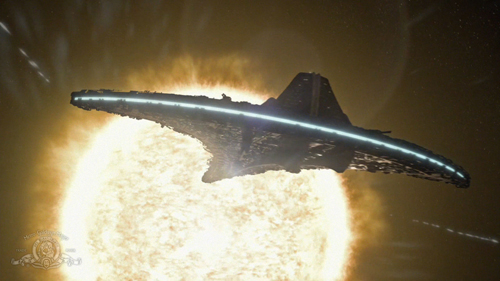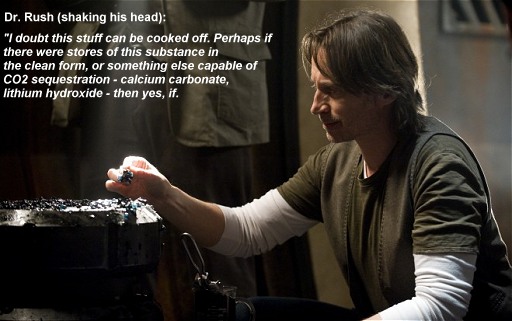A few weeks ago I wrote a blog post in favor of Stargate:Universe (SGU), which put the older Stargate fans up in arms against me. Our disagreements surprised me. I honestly did not think that in this day and age there are still viewers who like to watch old-style episodic TV. But apparently I was wrong.
There are still people who like to watch actual single-dimensional heroes, who are best friends without any disagreement between them, walk through a Stargate, blindly as to what’s on the other side, end up on different planets that almost all look just like outside of Vancouver, find a Medieval-like civilization each time, find aliens that look just like humans and where they all speak English, end up in some unlikely situation, and then have their team’s scientist patch together some alien & otherwise unknown technology through some completely unscientific way, and save the day in the last 10 minutes of the 45 minute episode. At the end, they step back to Earth, they have a quick laugh as a closing statement, and guess what, next week it will be the same base story again. Yay!
Well, let there be known that I hate with all my might such so-called “sci-fi”. That is not sci-fi, this is “Disney sci-fi”, as Stargate: Atlantis’ own David Hewlett called it. Even the actors of these shows don’t respect that kind of sci-fi (which of course heightened my own respect for Mr. Hewlett). These are some cheap, generic, pedestrian shows, void of any emotion, that do not engage the viewer in any way. It doesn’t make the viewer think, question his opinions about things, learn new ideas, neither make the viewer get immersed in their world — because it’s an unrealistic world.
Enter SGU.

The characters have actual personalities and are not stereotypical (Dr. Rush has got to be one of the best characters that ever graced the television medium in the last 60 years), there are sex scenes as they’re supposed to be, and there is drama — which is what’s the drive for any story since the invention of the Theater 2700 years ago. Some fans have said that SGU is over-dramatic and boring, but from the 36 episodes so far, I can only point my finger to about 2-3 such episodes. Others have said that “SGU is not like Stargate”, and all I can reply to that is: “Thank God!”. SGU has the added intellectual, adult part of the show about sacrifice (self- or forced), spying, caffeine and drug withdrawal, death, corruption, body-swap ethics, framing, attempted murder, alcoholism, abduction, revolution, promiscuity, authoritarianism, mutiny, religion, pregnancy & miscarriage, suicide, freedom of will, torture, depression, execution, euthanasia, HIV, murder & retribution, and of course, ultimately, Ascension, as a goal for any species.
Then there are the technical parts of the show, like the serialized manner the story is told, that feels natural to the viewer. Stories are not self-contained, but rather there is cause and effect, like with everything in real life. Nothing is for free. And then there’s great cinematography and amazing CGI, some of the best ever on TV. About 20 different recurring sets were built for the show, while it’s usually no more than 8-12 for other shows. Originally I hated the lighting of the show, but re-watching the show on Netflix I made a 180 degree change. Apparently the mpeg2 encoding has a detrimental effect in the gamma value of the stream, something that doesn’t happen when watching it encoded in h.264 from the master footage (as Netflix does). It looks perfectly cinematic.
But what’s really making me love SGU almost as much as I loved LOST, is the immersion to it. I’m able to watch a few episodes on Netflix Streaming and after that I’m high. I’m up there. In that million-year-old spaceship, “Destiny”, that’s literally falling apart — making it almost impossible to occupy. I feel alone. Tired. Hungry. Dirty. Hopeless. I’m marooned.
To be able to achieve this kind of feeling from your audience, is pure art.
And the way this works for me is because of the natural and realistic depictions of situations and science (for a show, of course). Instead of having the food, air, water, power, and resources problems solved within 10 minutes on the second episode (as older shows would deal with it), we get the first 6 episodes dealing with these very elemental, very important issues. And the ways these are solved are realistic, adding to the story and to the drama: the crew eats liquid protein for weeks before they found food on some planet, the air purifier requires special chemicals that “can’t just be cooked off” (as Rush perfectly explained) and need to be harvested elsewhere, water had to be extracted by some other planet and it sickens the crew because of alien bacterial life in it, while the ship’s power recharge mode almost leaves 15 people off-world because nobody understands how the ship works. And we have two shuttles, one of which is damaged and simply beyond repair (if that was SG-1/A, it’d be fixed in like, 10 minutes).

This is not a show where magically everything just works. There is pain, but there’s also wonder, there is mystery, there is even true scientific method. The Kinos were a great idea by the writers to analyze potential planets connected with stargates for breathable atmosphere — stargates thats thankfully were not used in every single episode like bread and butter. I absolutely LOVED how Rush had to wait MONTHS before his computer program cracked the ship’s master password, and he was finally able to stir it. In the first ~22 episodes, the ship was in auto-pilot! Heck, we learn about Destiny’s true mission in the 26th episode. We learn stuff as the crew learns it, in natural timeframes. This is not because the scientists of the show suck compared to the ones of the previous Stargate series, but because SGU is more realistic with less pseudo-scientific crapola in it. Of course it has some, but it’s significantly less than on most other shows.
This is what @tinkerware wrote on a review of SGU on the iTunes Store. He was very kind to let me copy his right-on-the-spot comment here, for all to read:
“This is a very smartly written show that shows the best side of sci-fi. It cuts the fake tech speak to a minimum while depicting a rich and consistent scientific and technological world. Anyone who watched the later episodes of Star Trek series can attest that “we can fix gizmo X if we reroute thingy Y from Z” dialog adds nothing and takes away enjoyment from the show. The remaining science and tech is intelligent, consistent and plausible (most of the time). Most important of all, this show does not forget what makes great sci-fi (hint: not GCI). Characters are well-drawn and compelling: everyone has their secrets and weaknesses; all of them are trying to survive a hostile environment. It’s a refreshing take after so many “captain of the universe” crap shows that pass as sci-fi. Of course, all this is a sure ticket to cancellation, which I’m told has already happened. Another reason to give up the cable subscription…”
Finally, another part that I love about SGU is how it handles the aliens. So far, in almost 36 episodes, we’ve only seen two humanoid alien types! And this is what also adds to the realism since according to many scientists today, there are probably a lot of currently habitable planets out there, but very few are expected to have intelligent life, and even fewer of them to carry humanoids. Sure enough, on SGU the stargate-connected planets are mostly vegetation planets with some animal life (most), dead civilizations (1), creatures/monsters (4), exotic alien forms (1), microbial life (1), robotic life (1). Overall, the SGU writers are following well Duncan Jones’ advices on how to create good sci-fi.
Of course, SGU has weaknesses. The communication stones being my main beef, since they reduce the existential element of the show. And strategic mistakes were made too: SGU should have been pitched to another channel, not SyFy (which had a specific kind of Stargate viewers). But none of these problems deter from thoroughly enjoying the show and recognizing it as one of the most serious, and well-written pieces of sci-fi television (in my top-5). Currently, it’s the only show I still watch on TV. In the last few weeks I stopped watching the remaining shows that previously had some of my attention: “V”, “No Ordinary Family”, “The Event” (complete pieces of shit), “Fringe” (interesting premise with bad execution), and even the too-lite-but-entertaining “The Vampire Diaries”. After the (bad) end of the otherwise excellent LOST, SGU is the best sci-fi show left on TV in my opinion. After the last episode is broadcasted in May, there would be nothing as exciting and realistic to replace it — and lose myself in it. In fact, this will be the FIRST time in almost 25 years where there won’t be any space-driven sci-fi on TV. It’s the end of an era.
Since SGU will end in a cliffhanger, I truly hope that either SyFy will order 2-3 tele-movies to conclude the story, or if that’s not possible (I don’t personally believe it’ll happen), I hope the producers can get a deal for 2-3 books. Here’s hope for at least that. It’s just very sad that so many people ignored SGU. It’s a little known gem. Who knows, it might end up becoming a cult show.








